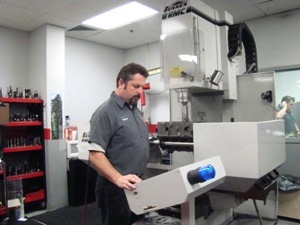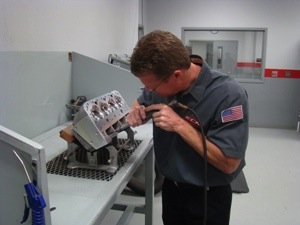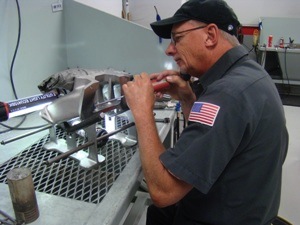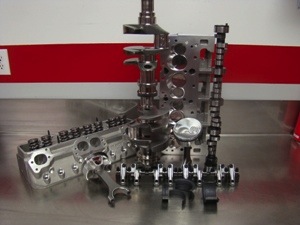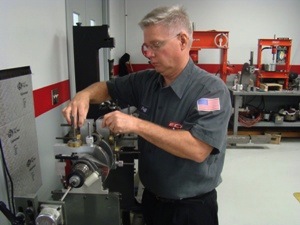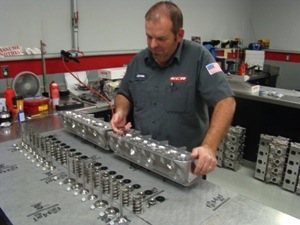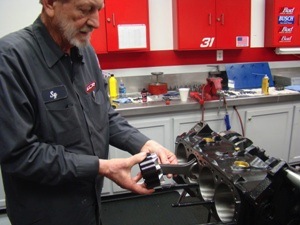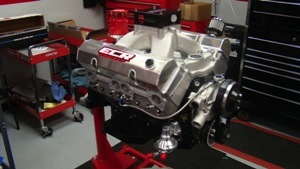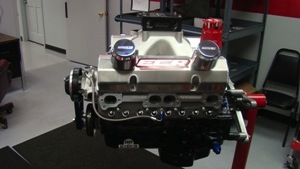Last month, we introduced you to the UMP Modified racing engine being built by the engine experts at Earnhardt Childress Racing in Welcome, NC. The engine – a 600 hp, 411 cid plant built for UMP Dirtcar Modifed competition – will be awarded to the winner of the Sunnen Rev It UP Raffle at the 2010 IMIS Show in Indianapolis, Dec. 1-3.
You can learn about the raffle – proceeds from which will benefit two extremely worthy charities – by reading Final Wrap on page 72 of last month’s issue of Engine Builder. We told you in that column that you would soon be getting significantly more detail about the components and machining operations used in building this engine and – true to our word – we are delivering.
Sure, you could spend $3 to buy a ticket for the raffle (in fact, why don’t you?) and reverse engineer the ECR engine for your own personal gain or you could look over the shoulders of the ECR team as they spec, prep and build the engine, in effect, giving away their $30,000 secrets.
Lanny Barnes, noted Nextel Nationwide Series engine builder for Earnhardt Childress Racing gives us an exclusive look at the steps he and his team followed during the engine’s construction. After all, as Spenny Clendenan, ECR’s Business Manager points out, “A lot of shops will be able to look at this engine, built with off-the-shelf parts, and change one little thing to make it their own."
The build started with a solid foundation. “We started with Little M Dart block with 4.1750” bore 350 main and 50mm cam tunnel,” Barnes says. “The 3.750? stroke results in 411 c.i.d. Press-on roller cam bearings are .0015?. Dart’s machine work is very good and to spec but still, out of box. we deburred block to remove any obvious sharp edges. All block machine work was done on Sunnen/RMC V30 CNC.”
Barnes says Sy Earnhardt made special note that extra clearance was needed in the timing belt area to accept the Jesel timing cover. The machine shop also bottom-tapped all bolt holes in block.
ECR made the decision to deck block to 9.000? deck ht. Operators bored the block for a .937? CHE lifter bushing with .050? oil hole. “We put .0008? press on bushing then final honed to .0009? clearance,” Barnes says. Ronnie Phillips then decked the standard 9.025? deck block to 9.000?.
”He bored the cylinders to 4.165? and then bored for lifter bushings,” explains Barnes. “Bubba McGee then installed lifter bore bushings so Ronnie could final ream finish lifter bores."
In order to keep the block exact during the boring process, BHJ torque plates were installed with the head gaskets to be used in final assembly.
The head bolts were torqued to the following specifications using ARP assembly lube:
Top Row: 65 ft.lbs
Mid Row: 65 ft.lbs
Mid. Outer torque: 55 ft.lbs
Outside Row: 65 ft. lbs
The block was then sent back to block prep where AJ Hilchey put the final touches on block. “While it was in its final CV-616 hone,” explains Barnes “McGee final honed the block to 4.1750?. He used Sunnen 518 stones down to .002? of finish size and then took Sunnen 625 stones to .0006? of finish size, finishing with Sunnen J-84 stone.”
While in the Sunnen CV-616 the ECR operators used the 400 grit hand ball hone to put a crosshatch in the lifter bushings as well as fuel pump push rod bore. Barnes says the mains were good but they also ran a hone through just to clean up.
Then they torqued the number one through five 7/16? bolts to 65 ft lbs; following with the numbers one and five 3/8? bolts 35 ft.lbs using ARP assembly lube.
”The crankshaft – a Winberg 3.750? 350 main 2.0 rod journal had a 1710 final bob weight,” says Barnes. “Jeff Hickernel spun the crank at ECR just to check that Randy Winberg’s work was spot-on as usual.” Barnes explains that the Engine Builder reader can order the same Dart block with the lifter bores in their final size as well as the cylinder hone finished.
“The cylinder heads we used – 15 degree Dart heads – can be ordered completely race ready out of the box. We final cut the combustion chambers to 47cc and also gave the intake and exhaust spring pad seat areas a .015? cut. The heads were final assembled by James Phelps.”
Parts Information
Block and Cylinder Heads
Dart (248-362-1188)
Cylinder Head p/n 14372030 15 deg. full port
Valves, Locks, Retainers
CV Products (336-472-2242)
Intake valves: p/n XIV2180-3412-R (Intake valve size: 2.180?)
Exhaust valves: p/n XEV1600-5640-341-R-1 (Exhaust valve size: 1.600?)
Spring Seat Locators: p/n CVSS 3374
Titanium Retainers: p/n XRE574-LTW
Titanium Valve Locks: p/n XLO691-C
Valve Seals: p/n CV 750
Valve Springs
PSI (248-486-3372)
p/n CT 1574 ML-TC
Pistons
CP Pistons (949-567-9000)
4.175 x 1.125 comp. ht. x .866 pin x 2.0 long
Wrist Pins
Weymoth .866 x 2.0
Piston Rings
Total Seal (800-874-2753)
Top ring # 555 04175 0415 MLY DUCT DF .134
2nd ring #554N 04175 0325 135 NO BEVEL NAP DF
4.170 Chrome Rail
4.175 3mm expander
Connecting Rods
Carrillo Rods (949-498-1800)
ECR-LM>66000S-00
6.000 Rod
3/8 bolt
573 gram
2.125 housing bore
.866 pin
Rocker Arms
T&D (Larry Torres 775-884-2292)
Shaft Rockers Steel with adjuster
1.9 Intake / 1.9 Exhaust
Camshaft
Comp Cams (901-795-2400)
p/n 12-000-10 Serial #:U 2532-10
4345BG/4349BG R 107
250 intake 258 exh. @.050
.396/.396
Push Rods
Smith Bros Push Rods (541-388-8188)
Timing Components
Jesel (732-901-1800)
Belt Drive # KBD 31200
Lifters # LFT 53451 (8) LFT 53450 (8) Order # 249842
Fasteners
ARP Fasteners (800-826-3045)
KIT p/n 534-9501
Other Components
Moroso (203-453-6571)
Valve Covers p/n 68326 Fab
Plug Wires p/n 7325
Oil Pan, Pickup
Stef’s Performance Products (732-367-8700)
Oil Pump
Melling Select Performance (517-787-8172)
p/n M55HV
Harmonic Balancer
ATI (877-298-5039)
Balancer p/n 917784
Intake
Edelbrock (310-781-2222)
Intake Manifold p/n 2846
Valley Tray p/n 2855
Ignition Components
MSD (915-857-5200)
Distributor p/n 85551
Machined fixed collar off distributor and replaced with adjustable.
MSD only offers fixed collar in single pick up distributors.
6ALN BOX p/n 6430
HVC Blaster Coil p/n 8252
